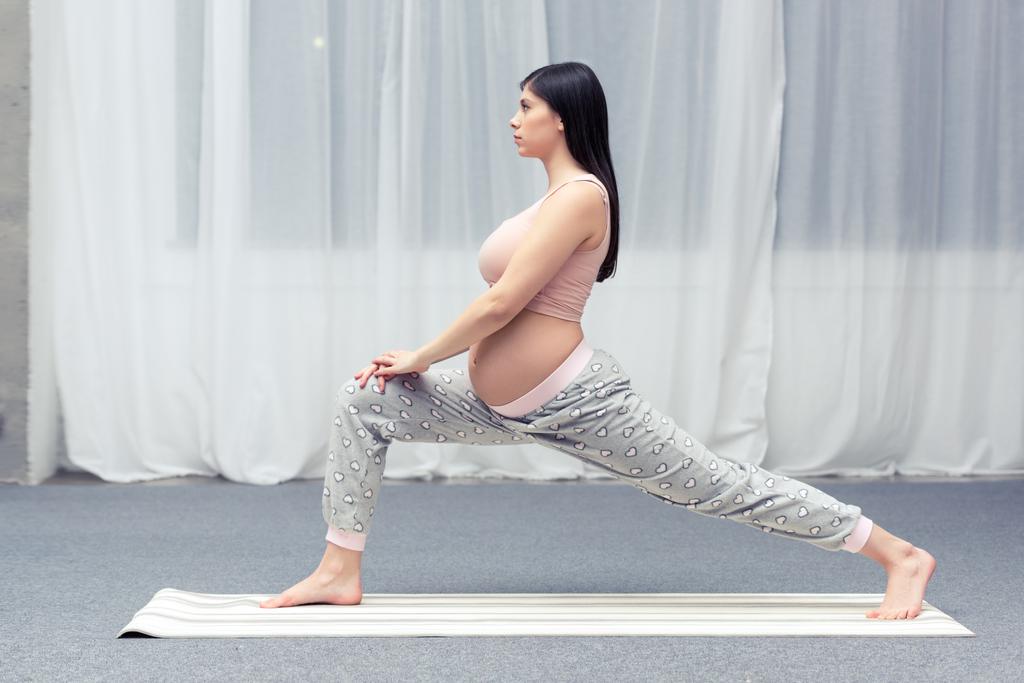Discover effective exercises to alleviate pelvic girdle pain and improve your overall well-being.
Exercises to Alleviate Pelvic Girdle Pain
Pelvic girdle pain can be a real pain in the…well, pelvis! But fear not, because there are exercises that can help alleviate the discomfort and restore your body’s balance. In this article, we’ll dive deep into the world of pelvic girdle pain, understand its causes and symptoms, explore the role of exercise in pain management, and discover different types of exercises that can bring relief. So let’s get started!

Understanding Pelvic Girdle Pain
Before we embark on our exercise adventure, let’s get to know pelvic girdle pain a bit better. Pelvic girdle pain refers to discomfort felt in the pelvic area, which includes the lower back, hips, and groin. It commonly occurs during pregnancy or after childbirth, but can also be caused by injury or other factors.
During pregnancy, hormonal changes can cause the ligaments in the pelvic area to become more relaxed and stretchy. This is necessary to accommodate the growing baby and prepare for childbirth. However, this increased flexibility can also lead to instability and pain in the pelvic girdle. The weight gain associated with pregnancy can also put additional pressure on the pelvic joints, exacerbating the discomfort.
In addition to pregnancy-related causes, poor posture and muscle imbalances can contribute to pelvic girdle pain. When we slouch or have weak core muscles, it can put strain on the pelvic area, leading to discomfort. Similarly, if certain muscles in the hips or lower back are tight or overactive, they can pull on the pelvic joints, causing pain.
Causes of Pelvic Girdle Pain
There’s no one-size-fits-all answer to what causes pelvic girdle pain, as it can vary from person to person. Some common culprits include hormonal changes during pregnancy, weight gain, poor posture, muscle imbalances, and even stress. It’s like a game of Clue, detective work might be needed to figure out the exact cause!
Stress, both physical and emotional, can play a role in pelvic girdle pain. When we are under stress, our bodies release stress hormones, such as cortisol, which can affect the way our muscles and joints function. This can contribute to muscle tension and imbalances, further aggravating the pelvic area.
Injury or trauma to the pelvic area can also lead to pelvic girdle pain. This can occur from accidents, falls, or even repetitive strain injuries. The impact or strain on the pelvic joints can cause inflammation and discomfort, making everyday activities more challenging.
Symptoms and Diagnosis
How can you tell if you’re experiencing pelvic girdle pain? Well, the symptoms can range from mild to severe, and may include pain in the lower back, hips, groin, or even shooting down the legs. Sometimes, the pain can make it difficult to perform daily activities or get a good night’s sleep. If you suspect you have pelvic girdle pain, it’s always a good idea to consult with a healthcare professional for a proper diagnosis.
In addition to pain, other symptoms of pelvic girdle pain can include a feeling of instability or “giving way” in the pelvic area. Some individuals may also experience difficulty walking or standing for prolonged periods. It’s important to note that these symptoms can vary from person to person, and a healthcare professional will be able to assess your specific situation.
When diagnosing pelvic girdle pain, healthcare professionals will typically conduct a thorough physical examination and ask about your medical history. They may also order imaging tests, such as X-rays or MRIs, to rule out other potential causes of your symptoms. It’s important to communicate your symptoms and any relevant information to your healthcare provider to ensure an accurate diagnosis.
The Role of Exercise in Pain Management
Now that we know what we’re dealing with, let’s talk about how exercise can come to the rescue! Regular exercise can help strengthen the muscles around the pelvis, improve flexibility, and boost overall stability. Plus, it releases feel-good endorphins that can lift your spirits and make you forget about the pain. Exercise truly is a superhero!
But wait, there’s more! The benefits of exercise go beyond just relieving pain. Let’s dive deeper into why regular exercise is so beneficial when it comes to tackling pelvic girdle pain.
Benefits of Regular Exercise
Exercise offers a plethora of benefits when it comes to tackling pelvic girdle pain. Not only does it help reduce pain and inflammation, but it also increases blood flow to the area, promotes healing, and improves your overall physical and mental well-being. It’s like hitting multiple birds with one stone, or should we say, doing multiple exercises with one squat!
When you engage in regular exercise, you’re not only strengthening the muscles around your pelvis, but you’re also improving their flexibility. This increased flexibility can help alleviate the tension and tightness that often contribute to pelvic girdle pain. Additionally, exercise helps to improve your overall stability, making you less prone to injuries and falls.
But the benefits don’t stop there! Exercise has a profound impact on your mental well-being as well. When you engage in physical activity, your body releases endorphins, which are natural painkillers and mood boosters. These endorphins can help lift your spirits and make you feel more positive, even in the face of pain. So not only are you strengthening your body, but you’re also giving your mind a much-needed boost.
Furthermore, exercise increases blood flow to the pelvic area, which can help reduce inflammation and promote healing. This improved blood circulation delivers essential nutrients and oxygen to the affected muscles, aiding in their recovery process. So not only are you relieving pain, but you’re also actively working towards healing and restoring your body.
And let’s not forget about the overall physical and mental well-being that exercise promotes. Regular physical activity has been shown to improve sleep quality, reduce stress levels, and boost self-confidence. By incorporating exercise into your pain management routine, you’re not only addressing the physical aspects of your condition, but you’re also taking care of your mental and emotional well-being.
So, as you can see, exercise is not just a one-dimensional solution to pelvic girdle pain. It offers a multitude of benefits that go beyond pain relief, including increased flexibility, improved stability, enhanced mental well-being, and overall physical health.
Precautions to Take Before Starting Exercise
Before you jump into your workout sneakers, there are a few precautions to keep in mind. First and foremost, always consult with your healthcare provider or a qualified exercise specialist to ensure that the exercises you choose are safe and appropriate for your specific condition. They can provide you with personalized guidance and recommendations based on your individual needs.
Additionally, it’s important to listen to your body and start slowly. Gradually increase the intensity and duration of your workouts to avoid overexertion or exacerbating your pain. Pushing yourself too hard too soon can do more harm than good, so take it at a pace that feels comfortable for you.
Another crucial aspect of exercising safely is proper warm-up and cool-down routines. Before starting your workout, take the time to warm up your muscles and prepare them for the upcoming activity. This can include gentle stretches, light cardio exercises, or mobility drills. Cooling down after your workout is equally important to help your muscles recover and prevent post-exercise soreness. Incorporate gentle stretches and relaxation techniques into your cool-down routine to promote muscle relaxation and reduce the risk of injury.
Remember, your muscles deserve some tender loving care too! So take the necessary precautions, listen to your body, and make exercise a safe and enjoyable part of your pain management journey.
Different Types of Exercises for Pelvic Girdle Pain
Now it’s time to explore the world of exercises that can bring relief to your achy pelvis. Think of these exercises as your personal army, ready to fight off the pain and restore balance to your body!
Stretching Exercises
Stretching exercises are a fantastic way to increase flexibility and relieve tension in the muscles around the pelvic area. Some great options include gentle yoga poses, hip stretches, and pelvic tilts. They’re like a breath of fresh air for your muscles, giving them the space they need to relax and unwind.
Strengthening Exercises
Strengthening exercises are like the secret agents of your exercise routine, helping to build strong muscles that support your pelvis. Try exercises that target your glutes, hamstrings, and core muscles, such as bridges, clamshells, and planks. They’ll have your back, or rather, your backside!
Aerobic Exercises
Who says exercise can’t be fun? Aerobic exercises, also known as cardio, get your heart pumping and your body moving. Go for low-impact options like swimming, walking, or cycling to minimize stress on your joints. It’s like a dance party for your pelvis, without the disco ball!
Creating a Balanced Exercise Routine
Now that we have a wide arsenal of exercises, it’s time to create a balanced routine that incorporates them all. Remember, variety is the spice of life, and your exercise routine is no different!
Incorporating Exercise into Your Daily Routine
The key to making exercise a habit is to find ways to incorporate it seamlessly into your daily routine. Try fitting in quick exercises during breaks, taking the stairs instead of the elevator, or even doing some low-impact exercises while watching your favorite TV show. Getting creative with your routine can make exercise feel like a walk in the park!
Tips for Staying Motivated
Let’s face it, staying motivated can sometimes be a challenge. But fear not, because we’ve got some tips up our sleeves to keep you on track. Find a workout buddy or join a group class for added accountability and fun. Set realistic goals and reward yourself when you reach them. And don’t forget to celebrate your progress along the way. You’re doing amazing, and your pelvis will thank you for it!
When to Seek Professional Help
While exercise can work wonders, there may come a time when you need to seek professional help. If your pain is not improving or if you experience any new or worsening symptoms, it’s important to consult with a physical therapist or exercise specialist. They’ll be able to assess your condition, provide personalized guidance, and ensure that you’re on the right path to recovery.

Recognizing When Pain Is Not Improving
It’s easy to get discouraged when the pain persists, but remember that you’re not alone. If you notice that your symptoms are not improving or are getting worse despite your best efforts, it’s time to reach out for help. Your body deserves the best care, and seeking professional guidance can help you get back on track.
Finding a Physical Therapist or Exercise Specialist
The search for a physical therapist or exercise specialist might sound daunting, but fear not, because they’re out there ready to lend a helping hand (or rather, a helping exercise)! Ask your healthcare provider for recommendations, do some online research, or seek referrals from friends or family who have experienced similar issues. With the right support team, you’ll be back to your pain-free self in no time!
And there you have it, a comprehensive guide to exercises that can alleviate pelvic girdle pain. Remember to always listen to your body, consult with professionals when needed, and have fun with your exercise journey. Your pelvis will thank you, and you’ll be back to rocking and rolling in no time!



